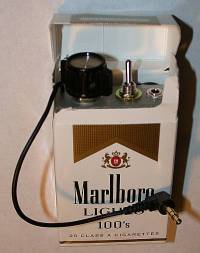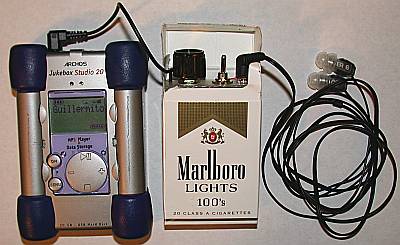My Marlboro CMOY Amp
1 Juin 2004 - updated April 2005
[WARNING: Extremely geeky text ahead]
Act I: discovery of electronics through autonomous robots
Some time ago, I became fascinated by small autonomous insect-like robots. Mainly BEAM robots, first invented by Mark Tilden, which do not use any micro-processor. I built a few commercial kits, including the excellent Cybug and other kits from the very good website SolarBotics. Then I tried to build my own from scratch and spare components. I thought that my knowledge of Intel assembler would help. I was totally wrong. Simple electronics asks for an analog way of thinking. Assembler, and programming in general, needs your brain to work in a digital and binary way. Both of these are not compatible, at least in the small piece of jello that I have between the ears. Which is curious, because my actual job, biology, is all about analog processes. When I used a programmable Basic Stamp II microprocessor in some projects, to be able to pilot electronic circuits with binary logic, than it became a little bit easier.
After a while, my daily fascination probably switched to something else, and I put my soldering iron, breadboards and half-finished projects in a box, where they stayed for a long time.
Act II: discovery of the audio geeks sub-world
Recently, reading some audio geek sites out of boredom, I became interested in do-it-yourself portable audio amplificators.
For a long time, I never really believed in high-quality audio. I thought that people spending thousands of dollars in perfect headphones, glass tube amplificators and other very high quality things, were just snobs without a life, spending hours arguing about some microscopic difference in sound quality that I would never be able to hear anyway.
Some time after buying my Archos mp3 player, and because I use it almost all the time in a noisy environment, I started to read a little bit about headphones and audio technology in specialized websites like HeadWize, Head-Fi or even HeadRoom (the only commercial site that is not afraid to trash some of the products they are selling - I love this attitude and I love people saying the truth, whatever the commercial consequences - actually in this case the consequence was positive, as I bought my headphones from these honest guys - honesty always pays at the end). Finally, I decided to buy a pair of Etymotic ER-6 very small headphones that have an excellent passive noise reduction by just sealing themselves inside your ear. And they have an excellent sound quality as well. These tiny headphones almost changed my life, and I rediscovered how music really sounds. That was the first giant step in quality.
So, reading about small portable amplificators, I learnt that you can buy some good ones for generally around $150, like the AirHead, or the Xin SuperMini. But reading around these sites, I more than once stumbled across people talking about something called a "CMOY Amp", very often cited as a sort of reference. The pictures showed some funny electronic circuits inside customized peppermint metallic boxes. I loved it.
I finally discovered that the CMOY Amp is a very simple but apparently powerful and good-quality amplificator, designed by some audio geek called Chu Moy. Instead of making money out of his design by selling or patenting it, he published the full information on the HeadWize site, so anybody could comment on it, or propose some new improvement to make it even better. True hacker and Open Source spirit, and I admire that. There are other people making money out of the design, for example by selling CMOY Amps already built on eBay (current search for "CMOY"), which once again shows that an open information philosophy is actually good from an economical point of view and for the consumers. But I digress. The bare components for a CMOY Amp cost around $20-$25, and it is very easy to build. I thought about my soldering iron, forgotten since long in its dusty box, and I suddenly heard its whisper: "use me!".
Act III: The electronics hobbyist meets the audio geek
Detailed schematics and a very useful step by step construction method is detailed at TangentSoft, the website of yet another audio geek (who published some more advanced amplificators designs too). Instead of ordering a few parts from different online electronics store, with the risk of doing an error, and having to wait for four or five different packages, a complete set of quality parts for one CMOY Amp can be purchased from David here, a nice guy who assembled a complete no-headache kit for total amateurs like me [Update : no more. But you can find the list of needed parts here or here, with complete illustrated step by step instructions]. It costs only $26.50, just a little bit more than the total price of raw components, and you have almost everything you need. A visit to the local Radio-Shack for a few dollars worth of additional stuff (like a volume-controlled small jack, which I hacked and included into my build to have a male input jack already set up, instead of the female jack input from the original design - which removes the need for an additional cable), and I was ready to start.
After a night battle with the small components, the wires, my magnifier, my stubborn meter, throwing solder everywhere except where I needed it, burning a few fingers, I finally got my amp. At the beginning, of course, it didn't work. After testing some points, I realized that a lousy connection caused a high resistance, and the current flowing from the power supply was not balanced at all, as it should have been. One hour lost on that. I started the audio test again. With some very cheap headphones, just in case some error would blow them up. I connected the input and output wires with crocodile clips to the main assembly, started my mp3 player, and began to turn the volume knob. This time I heard some music. Victory! So I tried with some old and not so bad Sony headphone I sometimes use. I remember the song was "El Calor del amor en un bar" by Gabinete Caligari. The very beginning, even before the bass starts, with a sort of cha-cha-cha / rock tempo, and this line that remembers me a few nights back in other countries, other times:
"Amor, la noche ha sido larga
y llena de emoción,
pero amanece y me apetece
estar juntos los dos."
I was blown away. Until this moment, the sound factor had been very theorical, I didn't really thought about it that much. It was more a funny electronics project. But the amelioration of the sound quality of the Sony headphones was amazing, jaw-dropping. With less than $30 of material, some funny soldering, and a plastic case salvaged from a trash. The quality jump was as big as when I switched from the cheap Archos headphones to the Etymotic ER-6. The effect of my Chu Moy amp is a little bit less evident when used with the Etymotic, which are already excellent, but still very noticeable. It's not easy to talk about the quality of sound for a non-specialist, but it's really crisper and richer on the whole range of frequencies and volume. And of course, you can make it much louder if you want, but that's not really an issue. So, my amp is my second giant step in audio quality. You can find an interesting review of a CMOY Amp here.
For fun, I've packed the whole stuff inside a Marlboro light cigarette pack, which is the brand I currently smoke. Because of the big knob, and because I really didn't try to do something compact, I had to use a pack of long 100's ones though. It's way too fragile to protect the weak soldered connections, but for the moment I will keep it like that, because it's cool. Maybe I will stuff it inside a Gauloises pack instead. And maybe I will use a mint box when I will quit smoking.
I remember when my friend Xavier, himself an audio geek, told me years ago that encoding mp3s at a fixed 128 kbps rate was not enough, I laughed at him, because I could never hear any difference with the original songs. Now, with my new audio toys, I'm starting to discover that he was right. On certain music pieces, I can clearly hear the distortion induced by a compression rate too low. I will probably have to re-encode some of my favorites CDs.
A few pictures to end this boring and geeky text. First, my weird looking new pack of Marlboro with a jack hanging from it. No, mister policeman, it's not a hidden bomb detonator (now I think about it, I should not use this amp when I'm flying - this and being french, they will shoot me on sight here). From left to right, we have the male input jack, the potentiometer volume knob, the on/off switch, and the output female jack. There is also a red LED behind the transparent piece of plastic that serves as a support.


Then, what's inside. Messy wiring, big capacitors and a 9 volts battery.

The last picture is my current portable audio system: an Archos 20 80 Gb mp3 player [I updated the hard drive when the original one died last november], with the firmware replaced of course by the wonderful Open Source RockBox, then my Marlboro CMOY Amp, then my Etymotic ER-6 headphones.

[Update april 2005 : my Marlboro CMoy Amp was cited in MAKE magazine about Do It Yourself projects, in Gizmodo, the famous blog about gadgets, and other websites. Wow! I am still using it almost every day, including once in a Boston - Paris flight (people looked at me strangely), but the Marlboro pack (still the same one) is now a bit worn out, as it is not as solid as a tin mint box.]
[guillermito a gmail com] - [Home]